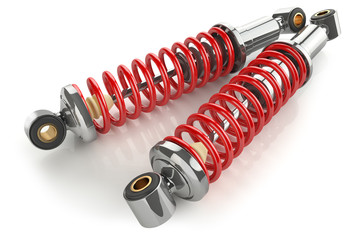The suspension system of a motorcycle plays a crucial role in the overall performance and handling of the bike. One of the critical components of the suspension system is the shock absorber.
It is responsible for absorbing the impact of bumps and rough roads, providing a smooth and comfortable ride. Measuring the length of a motorcycle shock absorber is essential in ensuring that the suspension is set up correctly and that the bike is safe to ride.
In this blog post, we will explain the importance of measuring shock absorber length, provide a brief overview of the different types of motorcycle shock absorbers, and give step-by-step instructions on measuring the shock absorber size.
Tips for Measuring The Length Of A Motorcycle Shock Absorber Accurately
- Make sure the bike is on a level surface and the shock absorber is in a neutral position before measuring.
- Measure carefully and double-check your measurements to avoid errors.
- It is always better to have professional help if you are not comfortable measuring.
It is worth noting that the measurement result may vary depending on the type of motorcycle, the way the shock absorber is mounted, and the measurement units used.
Tools and equipment needed for measuring:
- Tape measure or ruler
- Someone to help compress the suspension
How Do You Measure The Length Of A Motorcycle Shock Absorber?

Measuring the length of a motorcycle shock absorber is a relatively simple process that can be done with a few basic tools. Here is a step-by-step guide on how to measure the length of a motorcycle shock absorber:
Step 1: Measure the fully extended length of the shock absorber
First, ensure the bike is on a level surface and the shock absorber is fully extended. Use a tape measure or ruler to measure the distance from the mounting bolt’s center to the eyelet’s center or bushing at the opposite end of the shock absorber.
Step 2: Measure the fully compressed length of the shock absorber
To do this, sit on the bike in a riding position and have a friend compress the suspension by pushing down on the bike’s rear. Measure the distance from the center of the mounting bolt to the center of the eyelet or bushing at the opposite end of the shock absorber.
Step 3: Calculate the stroke length
Subtract the fully compressed length from the fully extended length to get the stroke length of the shock absorber.
Factors Affecting Shock Absorber Length
Several factors can affect the length of a motorcycle shock absorber, including:
1. Ride height
The ride height, or the distance between the ground and the bottom of the motorcycle frame, can affect the length of the shock absorber. A higher ride height will result in a longer shock absorber, while a lower ride height will result in a shorter shock absorber.
2. Suspension setup
The suspension setup, including the spring rate, preload, and damping, can also affect the length of the shock absorber. A stiffer spring rate or increased preload will result in a shorter shock absorber, while a softer spring rate or decreased preload will result in a more extended shock absorber.
3. Rider weight
The rider’s weight can also affect the length of the shock absorber. A heavier rider will compress the suspension more, resulting in a shorter shock absorber, while a lighter rider will compress the suspension less, resulting in a longer shock absorber.
4. Type of riding
The type of riding you do can also affect the length of the shock absorber. If you mostly ride on smooth roads, you will need a shorter shock absorber, while if you mostly ride on rough roads, you will need a longer shock absorber.
How To Adjust The Length Of A Shock Absorber
1. Adjusting the ride height
The ride height can be adjusted by adjusting the position of the shock absorber on the bike. This can be done by repositioning the mounting bracket or by installing longer or shorter shock absorber links.
2. Adjusting the spring rate or preload
The spring rate or preload can be adjusted by turning the adjustment knobs or rings on the shock absorber. This can be done to change the suspension for the rider’s weight or the type of riding being done.
3. Adjusting the damping
The damping can be adjusted by turning the adjustment knobs or rings on the shock absorber. This can be done to adjust the suspension for the rider’s weight or the type of riding being done.
4. Replacing the shock absorber
If the length of the shock absorber cannot be adjusted to the desired size, it may be necessary to replace it with a shock absorber of the correct length.
Are All Shock Absorbers The Same Length?
No, shock absorbers are not all the same length. The length of a shock absorber can vary depending on the specific model and application. The length is determined by the amount of travel required for the suspension system and the space available in the vehicle.
For example, a shock absorber for a car may have a shorter length than a shock absorber for a truck or SUV, as the truck or SUV may have a greater amount of suspension travel. Additionally, the size of shock absorbers may vary between different models of the same vehicle, as manufacturers may design other suspension systems for different trim levels or options.
Conclusion
Measuring the length of a motorcycle shock absorber is essential in ensuring that the suspension is set up correctly and that the bike is safe to ride. The length of a shock absorber can be affected by several factors, including ride height, suspension setup, and rider weight.
To adjust the length of a shock absorber to account for these factors, one can change the ride height and suspension setup or replace the shock absorber. It is always better to have professional help if you are uncomfortable with adjustments. Regularly measuring and adjusting the shock absorber length can ensure optimal performance and handling of the motorcycle.







